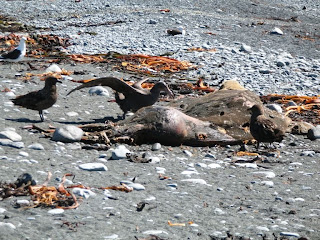There aren't many species of higher plants on Macquarie Island. Some of the prevalent ones are Stilbocarpa polaris



and me sitting among King penguins. The King's are very curious and if you get down to their height they come up to inspect you. They'll often peck at your clothing.

In many places the beach is covered with penguins and seals, making it difficult to navigate around them. It's not uncommon to have to climb up the hills behind the beach to make your way without disturbing them.

The Royals are also very handsome with large, prominent eyebrows (I'm sure that's not the proper term). They breed only on Macquarie Island, and the breeding colonies are huge.
There are Gentoo's, which are 75 to 90 cm tall. Rockhoppers look much like Royals, with large eyebrows (sorry no decent photo at this time).

There are quite a few grasses. The Macquarie Island tussock grass (Poa cookii) is the largest, and most impressive.

A lot of the plant cover consists of tiny things like the Azorella (below), which grows very slowly and forms cushions over a long period of time.

One of the most impressive plants is the Bull kelp (Durvillaea antarctica). Most of the rocks on the coast are covered with huge beds of this tough, leathery plant.
The animal life is everywhere. It's difficult to give a good feel of the level of daily interaction we have with wildlife. The animals are mostly unafraid of people, and it's easy to get very close. Here's Tim next to an Elephant seal.

and me sitting among King penguins. The King's are very curious and if you get down to their height they come up to inspect you. They'll often peck at your clothing.


In many places the beach is covered with penguins and seals, making it difficult to navigate around them. It's not uncommon to have to climb up the hills behind the beach to make your way without disturbing them.
Four kinds of penguins are commonly found on Macquarie. The King penguin is the largest (85 to 95 cm tall) and the most spectacular.

The Royals are also very handsome with large, prominent eyebrows (I'm sure that's not the proper term). They breed only on Macquarie Island, and the breeding colonies are huge.
There are Gentoo's, which are 75 to 90 cm tall. Rockhoppers look much like Royals, with large eyebrows (sorry no decent photo at this time).

Seals and penguins were slaughtered for their oil. Remnants of this industry remain. Here is some kind of a cooking pot (a pressure cooker, I think). In some places there is a soil horizon (layer) made of penguin bones. I like this photo that makes it look like penguins are flowing from the spigot.


Here's a Kelp gull

and a Sooty albatross

Two kinds of seals are common. Elephant seals are huge, lumbering things

and a Sooty albatross

Two kinds of seals are common. Elephant seals are huge, lumbering things
whereas fur seals are small, doglike critters. Here's a Fur seal pup that's been hanging around the station. He's been nicknamed Charlie, and you can easily get a foot or two from him. He acts like he'd like to be petted and scratched - but their teeth are very sharp and menacing.

Special mention for the rabbits. An introduced species, they've caused extensive damage, as can be seen here.


Special mention for the rabbits. An introduced species, they've caused extensive damage, as can be seen here.








No comments:
Post a Comment